This article was published in Scientific American’s former blog network and reflects the views of the author, not necessarily those of Scientific American
Time for another article on placental mammal phylogeny, again focusing on results that are still not tremendously well known outside the zoological community (for previous articles go here for a general introduction to placental phylogeny, and here for thoughts on the position of pangolins). This time, we’re going to look at in-group relationships within dog-branch Carnivora, and specifically at skunks. As before, this stuff won’t be at all new to those of you for whom it’s not at all new. In other words, if you’re thinking “but I already knew that”, stop reading, and go and spend your time more wisely. For the rest of you...
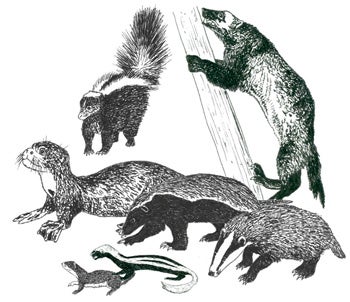
A montage featuring those groups conventionally included within Mustelidae. But should skunks really be there? Images from the in-prep Tet Zoo Big Book (as it's become known).
For much of the 20th century, virtually all of the smaller dog-branch carnivorans that are not members of Procyonidae (the raccoon family) were lumped together in the large group Mustelidae, popularly termed the weasel family. Mustelid diversity is such that there’s an established tradition of classifying its many species into as many as six ‘subfamilies’, including (but not limited to) Lutrinae (otters), Melinae (badgers), Mustelinae (weasels and martens), Mellivorinae (ratels), Guloninae (wolverines) and Mephitinae (skunks). Most of these groups share enough characters – both morphological and molecular – to show that they really do belong together.
On supporting science journalism
If you're enjoying this article, consider supporting our award-winning journalism by subscribing. By purchasing a subscription you are helping to ensure the future of impactful stories about the discoveries and ideas shaping our world today.
Oh, and... the relationships hypothesised between those several group is an interesting and complex issue all of its own. Views on mustelid phylogeny have varied so much that it’s difficult to imply that there's ever been anything like a consensus, but I suppose the most commonly held view is that otters, badgers and skunks are outside a clade that contains ratels, wolverines, weasels and martens (Simpson 1945, Bryant et al. 1993, McKenna & Bell 1997, Baskin 1998, Bininda-Emonds et al. 1999). Recent molecular studies have overturned this hypothesis: Mustelinae of ‘Simpsonian’ tradition (see Bryant et al. 1993) has proved notably paraphyletic, with wolverines and martens being positioned some distance from weasels and stoats (Koepfli et al. 2008, Sato et al. 2004, 2012), and grisons, striped polecats, marbled polecats and zorillas being close kin of otters (Sato et al. 2012).
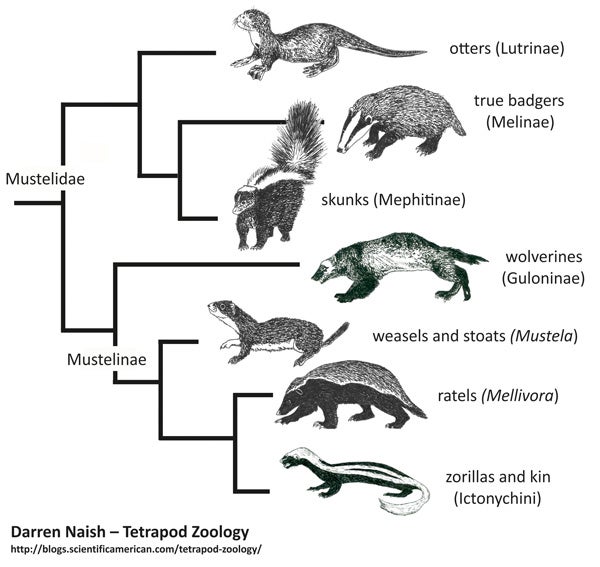
One of the consensus trees for mustelids produced by Bryant et al. (1993). Note that skunks are nested within Mustelidae and, as per many morphology-based hypotheses, are close to badgers and otters.
Anyway, those ‘conventional’ classifications show skunks as being close to otters, or to otters and badgers together. However, during the late 1980s weird results started to come in following the use of various different molecular techniques: they showed skunks grouping away from mustelids proper, and outside the clade that included Procyonidae and Mustelidae (Wayne et al. 1989). This result was mostly ignored and wasn’t bigged up at all in the initial paper that discovered it (Wayne et al. 1989). It was, however, acted on by Dragoo & Honeycutt (1997) who found essentially the same topology and proposed that skunks should be elevated to ‘family’ level. Mephitidae was born.
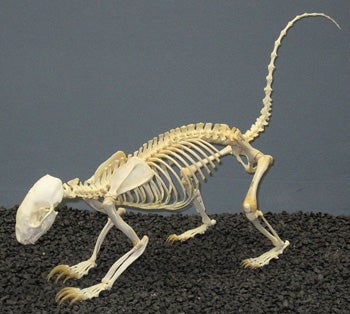
The skunk skeleton (this is of a hog-nosed skunk) is mustelid-like overall, but is this evidence of a close relationship with mustelids proper? Hog-nosed skunks have especially big hand claws - lots of interesting adaptations here for terrestrial foraging and scratch-digging. Photo taken at Museum of Osteology, Oklahoma, by Sklmsta. In public domain.
This result has since been recovered in other studies of carnivoran phylogeny and it’s now widely agreed that skunks are not mustelids at all (Sato et al. 2004, 2012, Flynn et al. 2005, Agnarsson et al. 2010, Eizirik et al. 2010, Meredith et al. 2011, Nyakatura & Bininda-Emonds 2012), being less closely related to them than are raccoons and (probably) red pandas*. This view is contradicted by at least some anatomical data, since skunks share cranial characters with otters (Wolsan 1999). Sato et al. (2004) argued that, because this molecular result contradicted the morphological and fossil evidence placing skunks within Mustelidae, the best course of action might be to be conservative and maintain skunks as a mustelid ‘subfamily’ for now. I get the impression that people have given up on this suggested conservative approach, perhaps because the molecular results placing skunks away from Mustelidae have been repeatedly recovered and look more robust than morphology-based results. Indeed, Wang et al. (2005) – in their analysis of fossil skunks – noted that the anatomical data used to link skunks to mustelids wasn’t especially convincing and relied on assumptions about the ancestral condition for the skunk clade.
* I should note that Agnarsson et al. (2010) found skunks and procyonids to form a clade, and red pandas to be the sister-group to canids! This study reported several anomalous results that have been treated with some suspicion.
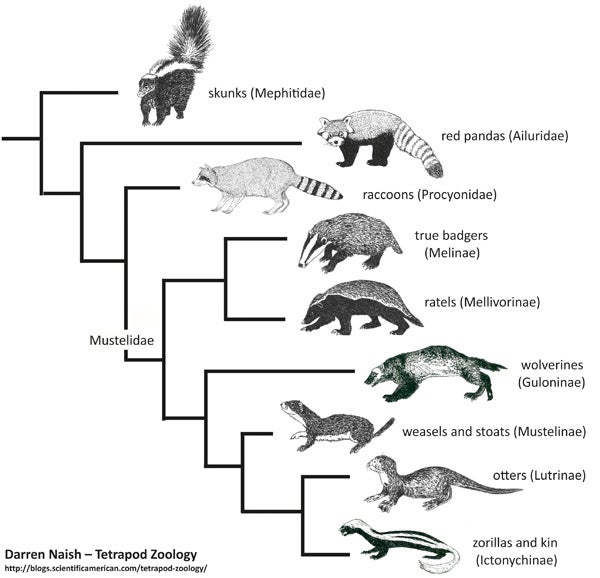
Revised phylogeny of mustelids and kin based on strict consensus recovered by Sato et al. (2012). Note that skunks are not mustelids at all, and in fact are further from mustelids than are raccoons and red pandas. The relationships between the main mustelid lineages is also different from what's been suggested on the basis of morphological data.
Things don’t stop there. Skunks are famously American (despite their appearance as European forest animals in all those Disney films). Or are they? A long-running controversy in carnivoran phylogeny concerns the position of Mydaus, the two stink badgers of the Malay Archipelago (one of which is sometimes given the generic name Suillotaxus). These animals are short-tailed and long-snouted, and they do look somewhat badger-like. But they also look skunk-like, resembling in particular the hog-nosed skunks (Conepatus). And, in true skunk-like fashion they can squirt foul-swelling fluid from their anal glands.
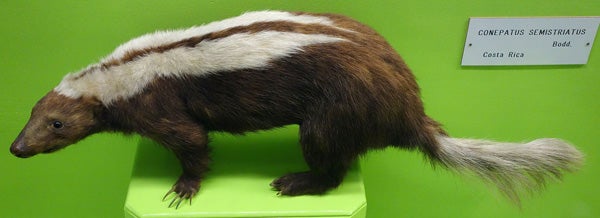
Striped hog-nosed skunk Conepatus semistriatus photographed at Museo Civico di Storia Naturale di Genova, Italy. Photo by Daderot, in public domain.
So, what to do? Many authors have regarded stink badgers as members of the badger clade, properly called Melinae. However, Radinsky (1973) memorably posed the question “Are stink badgers skunks?” after finding that stink badgers were importantly skunk-like in brain anatomy as well as in middle ear and tooth anatomy. Other authors – going back to Pocock in the 1920s – had also suggested skunk affinities for this group. This now seems correct: several molecular studies have found Mydaus to be a skunk, and the sister-taxon to the American skunk clade (Dragoo & Honeycutt 1997, Sato et al. 2012).
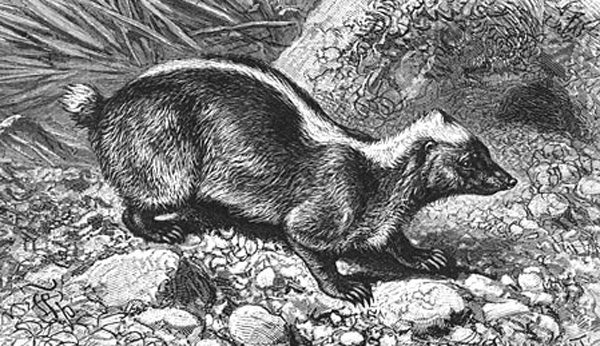
Ilustration of a Sunda stink badger Mydaus javenensis by A. E. Brehm (image in public domain). Note how this animal looks overall like a hog-nosed skunk but with a shorter tail.
So skunks are no longer exclusively American. But, actually, they haven’t been for a while, since we’ve known of fossil skunks from Eurasia since the 1800s. Palaeomephitis, Miomephitis, Plesiomeles, Nanomephitis, Promephitis and Mesomephitis from the Miocene of Europe and Asia have all classically been identified as Old World fossil skunks. Some of these – Palaeomephitis and Promephitis – might even be especially close relatives of Mydaus (Wang et al. 2005). However, the complex fossil history, biogeography and origins of skunks is not the issue we’re covering here today.
Skunks are almost certainly not mustelids. Stink badgers are almost certainly skunks and not badgers, and skunks dwell in tropical Asia as well as the Americas.
For previous articles on placental phylogeny, see...
And for other Tet Zoo articles on carnivorans, see...
Dissecting lions and tigers: Inside Nature’s Giants series 2, part III
Mystery big cat skulls from the Peruvian Amazon not so mysterious anymore
Conservation Concerns for South America's Remarkable Endemic Dogs
Hunter and Barrett's A Field Guide to the Carnivores of the World
Refs - -
Agnarsson, I., Kuntner, M. & May-Collado, L. J. 2010. Dogs, cats, and kin: A molecular species-level phylogeny of Carnivora. Molecular Phylogenetics and Evolution 54, 726-745.
Baskin, J. A. 1998. Mustelidae. In Janis, C. M., Scott, K. M. & Jacobs, L. L. (eds) Evolution of Tertiary Mammals of North America. Volume 1: Terrestrial Carnivores, Ungulates, and Ungulatelike Mammals. Cambridge University Press, pp. 152-173.
Bininda, Emonds, O. R. P., Gittleman, J. L. & Purvis, A. 1999. Building large trees by combining phylogenetic information: a complete phylogeny of the extant Carnivora (Mammalia). Biological Reviews 74, 143-175.
Bryant, H. N., Russell, A. P. & Fitch, W. D. 1993. Phylogenetic relationships within the extant Mustelidae (Carnivora): appraisal of the cladistic status of the Simpsonian subfamilies. Zoological Journal of the Linnean Society 108, 301-334.
Dragoo, J. W. & Honeycutt, R. L. 1997. Systematics of mustelid-like carnivores. Journal of Mammalogy 78, 426-443.
Eizirik, E., Murphy, W. J., Koepfli, K.-P., Johnson, W. E., Dragoo, J. W., Wayne, R. K. & O’Brien, S. J. 2010. Pattern and timing of diversification of the mammalian order Carnivora inferred from multiple nuclear gene sequences. Molecular Phylogenetics and Evolution 56, 49-63.
Flynn, J. J., Finarelli, J. A., Zehr, S., Hsu, J. & Nedbal, M. A. 2005. Molecular phylogeny of the Carnivora (Mammalia): assessing the impact of increased sampling on resolving enigmatic relationships. Systematic Biology 54, 317-337.
Koepfli, K. P., Deere, K. A., Slater, G. J., Begg, C., Begg, K., Grassman, L., Lucherini, M., Veron, G. & Wayne, R. K. 2008. Multigene phylogeny of the Mustelidae: resolving relationships, tempo and biogeographic history of a mammalian adaptive radiation. BMC Biology 6 (1). 4-5.
McKenna, M. C. & Bell, S. K. 1997. Classification of Mammals: Above the Species Level. Columbia University Press, New York.
Radinsky, L. 1973. Are stink badgers skunks? Implications of neuroanatomy for mustelid phylogeny. Journal of Mammalogy 54, 585-593.
- ., Wolsan, M., Prevosti, F. J., D’Elía, G., Begg, C., Hosoda, T., Campbell, K. L. & Suzuki, H. 2012. Evolutionary and biogeographic history of weasel-like carnivorans (Musteloidea). Molecular Phylogenetics and Evolution 63, 745-757.
Simpson, G. G. 1945. The principles of classification and a classification of mammals. Bulletin of the American Museum of Natural History 85, 1-350.
Wang, X., Whistler, D. P. & Takeuchi, G. T. 2005. A new basal skunk Martinogale (Carnivora, Mephitinae) from Late Miocene Dove Spring Formation, California, and origin of New World mephitines. Journal of Vertebrate Paleontology 25, 936-949.
Wayne, R. K., Benveniste, R. E., Janczewski, D. N. & O’Brien, S. J. 1989. Molecular and biochemical evolution of the Carnivora. In Gittleman, J. L. (ed.) Carnivore Behavior, Ecology, and Evolution. Comstock Publishing Associates, Ithaca, NY, pp. 465-494.
Wolsan, M. 1999. Oldest mephitine cranium and its implications for the origin of skunks. Acta Palaeontologica Polonica 44, 223-230.